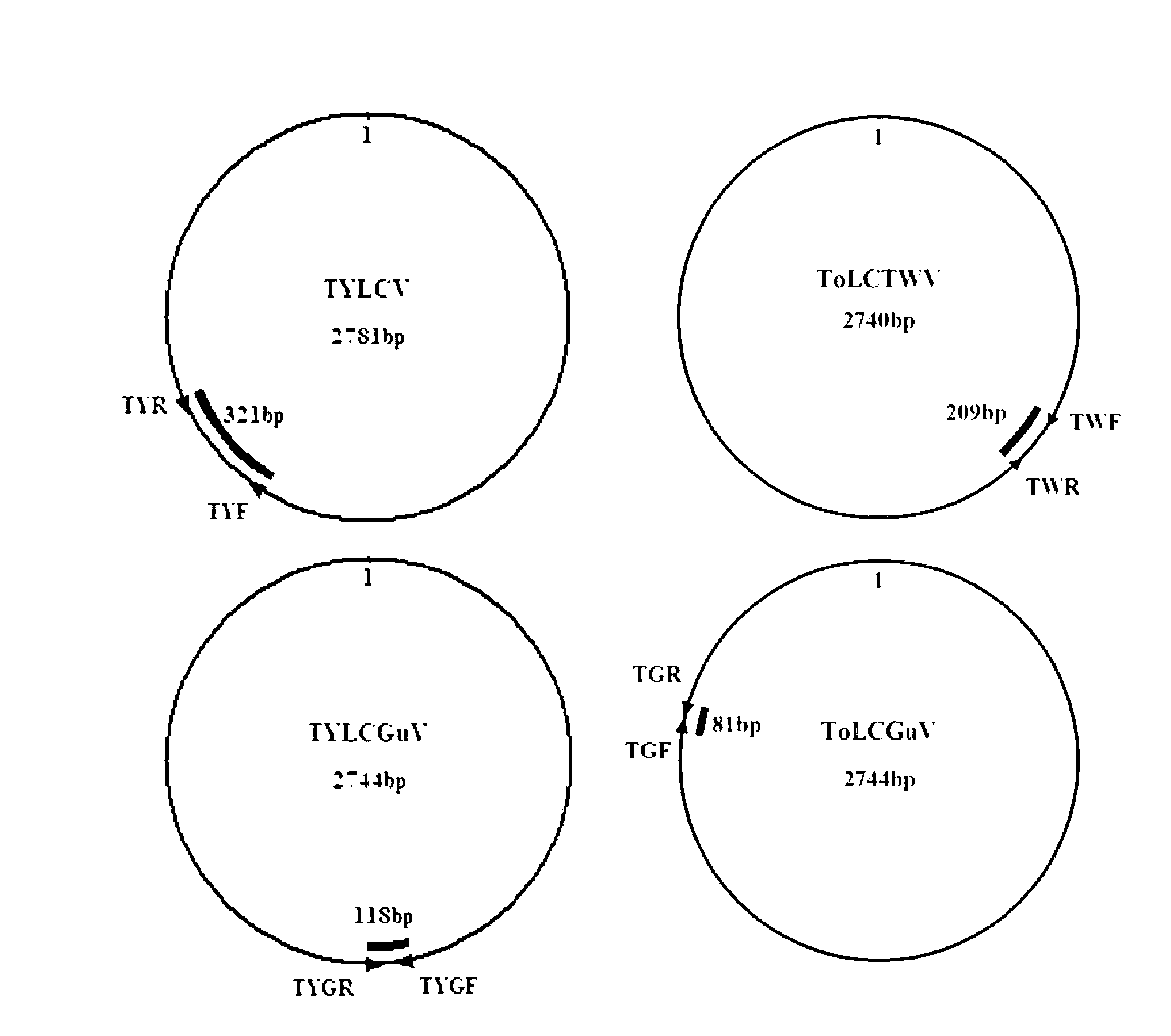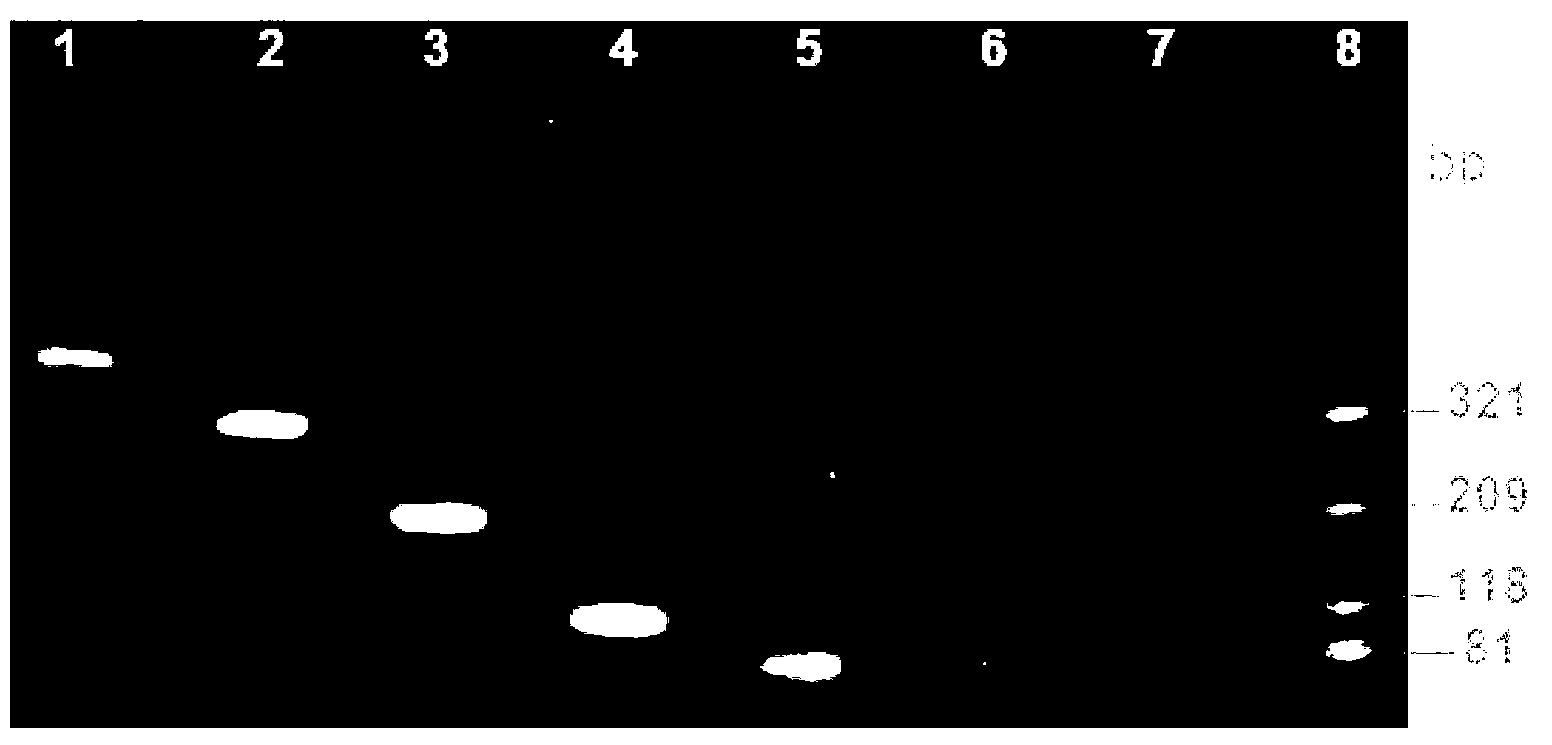Method and kit for synchronously detecting four viruses inducing tomato yellow leaf curl disease
A technology for tomato yellowing curved leaves and tomato koji, applied in biochemical equipment and methods, microbial determination/inspection, etc., can solve problems such as difficulty in identifying viruses, and achieve accurate and reliable identification results, strong adaptability, and increased cost. Effect
- Summary
- Abstract
- Description
- Claims
- Application Information
AI Technical Summary
Problems solved by technology
Method used
Image
Examples
Embodiment 1
[0049] The design of the primer of embodiment 1
[0050] According to the four viruses that cause tomato yellow leaf curl disease, tomato yellow leaf curl virus (TYLCV, international GenBank accession number is JQ867092), Taiwan tomato leaf curl virus (ToLCTWV, international GenBank accession number is DQ237918), Guangdong tomato yellow leaf curl virus For the genome sequences of leaf virus (TYLCGuV, the international GenBank accession number is AY602166) and Guangdong tomato leaf curl virus (ToLCGuV, the international GenBank accession number is AY602165), four pairs of specific primers were designed. figure 1 .
[0051] The primers for detection of tomato yellow leaf curl virus (TYLCV) were TYF and TYR, and the PCR amplification product size was 321bp;
[0052] TYF: 5'-GACCTGGCCCCACATTGTTTTGCCT-3';
[0053] TYR: 5'-TCAGCAATCTGCCAACGACGCA-3';
[0054] The primers for the detection of Taiwan tomato leaf curl virus (ToLCTWV) were TWF and TWR, and the PCR amplification produc...
Embodiment 2
[0063] Example 2 Detection and identification of known disease samples
[0064] The known disease samples included 1 disease sample infected by TYLCV, ToLCTWV, TYLCGuV and ToLCGuV alone, 1 tomato disease sample infected by TYLCGuV and ToLCGuV mixed, and another healthy tomato sample was taken as a control.
[0065] The flow chart of the method for detection and identification of tomato yellow leaf curl caused by four kinds of virus infection is as follows: figure 2 shown.
[0066] (1) Extraction of total DNA from tomato samples
[0067] Use a sterile new blade to take 100 mg of leaf tissue from the leaves of the sample to be tested, grind it into powder with liquid nitrogen, and place it in a 1.5 mL centrifuge tube; add 500 μL of tomato disease sample total DNA extraction buffer preheated at 65°C. The ingredients include 2% (w / v) CTAB, 1.4M NaCl, 0.02M EDTA, 0.01M Tris-HCl, and 0.2% (v / v) mercaptoethanol before use; placed in a 65°C water bath for 40 minutes; added 500 μL o...
Embodiment 3
[0074] Embodiment 3 Detection and identification test of unknown disease samples
[0075] 10 tomato samples collected from many areas in Guangdong were sampled, a total of 10 samples were obtained and numbered, and the corresponding collection locations and symptoms of each sample were shown in Table 1. The method used for detection and identification is the same as that used in Example 2, and each sample is detected by a single PCR (only one pair of primers in the above 4 pairs of primers are added to the single PCR reaction system, and the rest conditions are the same as those in Example 2). , to compare and verify.
[0076] The result is as Figure 4 and as shown in Table 1, Figure 4 Middle: M: standard molecular weight (100bp gradient); 1-10: Chenghai, Shantou, Zengcheng, Guangzhou, Gaoyao, Zhaoqing, Gaoyao, Guangzhou, Huadu, Guangzhou, Sanshui, Foshan, respectively. Samples to be tested from Zengcheng in Guangzhou, Xinyi in Maoming and Baiyun in Guangzhou; 11: Standar...
PUM
 Login to View More
Login to View More Abstract
Description
Claims
Application Information
 Login to View More
Login to View More - Generate Ideas
- Intellectual Property
- Life Sciences
- Materials
- Tech Scout
- Unparalleled Data Quality
- Higher Quality Content
- 60% Fewer Hallucinations
Browse by: Latest US Patents, China's latest patents, Technical Efficacy Thesaurus, Application Domain, Technology Topic, Popular Technical Reports.
© 2025 PatSnap. All rights reserved.Legal|Privacy policy|Modern Slavery Act Transparency Statement|Sitemap|About US| Contact US: help@patsnap.com



